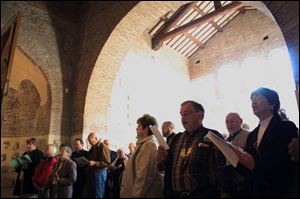
Pilgrimage puts 2 faiths on road to unity
2/9/2008
Lutheran and Catholic pilgrims share common prayer at the Saint Callistus Catacombs in Rome.
In an 11th floor ballroom in a Berlin hotel, a group of Ohioans started an 11-day pilgrimage by participating in religious services.
Bishop Leonard Blair of the Toledo diocese presided over morning Mass for 19 Catholics, and on the other side of the wall, Bishop Marcus Lohrmann led 39 Lutherans in a Communion service.
The memories of the trip and the opportunities that participants took home from their journey will be discussed by a panel tomorrow afternoon in a free public presentation at Lourdes College.
In Berlin, members of the two groups could hear each other's singing and responses through the hotel's wall, reminding them of the harsh realities of the 500-year-old schism between the two denominations.
"To share the Eucharist - and not to be able to share it with our Roman Catholic brothers and sisters - in a city that was divided not so many years ago, was a poignant reminder of the gift of unity in the cross of Christ and the ongoing pain of division within the Christian household," said Bishop Lohrmann, head of the Northwest Ohio Synod of the Evangelical Lutheran Church in America.
Sally Oberski, director of communications for the Toledo Catholic Diocese, was on the trip and also noted the irony of the divided services. Yet she felt there was a spirit of unity among the 58 people who spent 11 days traveling in Europe to see key historical sites for both denominations.
"Here we were in Berlin, the place where the Berlin Wall came down, and yet there was this hotel wall between us. It was very painful in some ways," Ms. Oberski said. "But we also respected our differences and focused on our commonalities."
The Rev. James Peiffer, a retired Toledo priest who heads the diocese's Ecumenical and Interreligious Affairs Commission, pointed out that Lutherans and Catholics share 1,500 years of history - from the time of Jesus until Martin Luther's protests led to the Protestant Reformation in 1530.
"We share three-quarters of our history when you think about it," Father Peiffer said. "We both have things to offer one another."
The European trip, which began Oct. 17 and ended Oct. 27, grew out of 30 years of dialogue between Catholic and Lutheran leaders, Bishop Lohrmann said in an interview.
Those discussions led to the landmark signing of the Joint Declaration of the Doctrine of Justification by Faith in Augsburg, Germany, on Oct. 31, 1999.
On a local level, the late Bishop James Hoffman of the Toledo diocese and Bishop Lohrmann signed a Joint Declaration on Sept. 16, 2001, giving the global accord a local focus.
That document was affirmed by Bishop Lohrmann and Bishop Hoffman's successor, Bishop Blair, who renewed the accord on its fifth anniversary in 2006.
Members of a commission on ecumenism, or Christian unity, from the Toledo diocese and the Lutheran synod came up with the idea of having the bishops lead a delegation from their local body to visit European sites important to the denominations.
Among the notable places in Lutheran history that the group visited were Eisleben, the German city where Luther was born in 1483 and died in 1546; Wittenberg, where he lived from 1508 to 1546 and where he nailed his 95 theses to a church door; Wartburg Castle, where Luther translated the New Testament into German, and Augsburg, a Renaissance town where Protestant and Catholic leaders met in 1530 to try to resolve their differences.
The group then traveled to Rome and toured the Vatican and the Catacombs and the Basilica of St. Paul, took part in a Papal audience, and visited a number of other Roman Catholic sites.
They also traveled to Assisi, home of St. Francis, the 12th century saint and a dominant figure in Christian history.
At the Papal audience, which had a crowd of about 30,000 people, Bishop Blair made arrangements for the group to have special seating and for Bishop Lohrmann to meet Pope Benedict XVI face to face.
The Pontiff also made a public announcement welcoming the Ohio delegation.
"I had a brief conversation with Pope Benedict and I was grateful for that," Bishop Lohrmann said.
He said he told the Pope that he brought greetings from Lutherans in northwest Ohio, and in response Pope Benedict "told me how much he appreciated the importance of Lutheran-Catholic dialogue, and that it continues to be a matter of importance to him."
The trip was filmed by a Washington company and will be made into a documentary likely to be released this fall, Ms. Oberski said.
Members of the two denominations sought to build inter-denominational relationships during the trip, making an effort to sit with people they didn't know when traveling or dining, according to Father Peiffer and Ms. Oberski.
Ms. Oberski said those informal discussions at meals or on the bus yielded many personal highlights among the pilgrims.
"Many people have told me that was one of the best things about the trip," she said.
The journey will continue produce benefits, she said.
"This group of pilgrims [is] saying, 'Where do we go next? What are we going to do next?' This is not just a great trip to Europe, it is going to lead to much greater things," Ms. Oberski said. "We're not going to let this momentum slow down."
The lecture on Reflections on an Ecumenical Journey: Fostering Spiritual Ecumenism, featuring a panel of people who participated in the trip, will begin at 3 p.m. tomorrow in the Franciscan Center of Lourdes College. Admission is free. Information: 419-824-3819 or www.lourdes.edu/ecumenical.
Contact David Yonke at:
dyonke@theblade.com
or 419-724-6154.